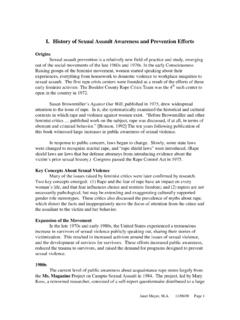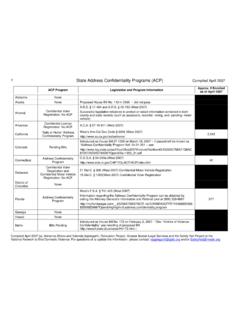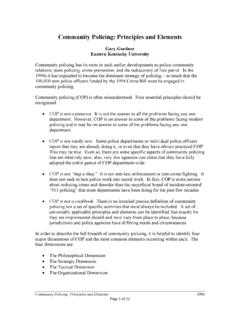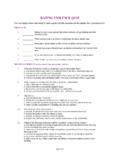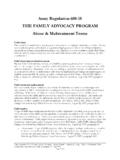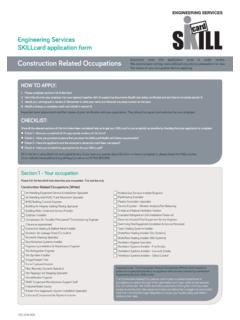Transcription of II-7 Military No-Contact Order 3-21b AR 608-18
1 AR- 608-18 September 2004 (revised May 30, 2006) Page 1 of 3 Military No-Contact Order ( 3-21b ) AR 608-18 (b) Military No-Contact orders are similar to civilian temporary restraining orders. They may be ex parte if the issuing authority considers it necessary to ensure the safety and security of persons for whom the command is responsible. In cases not requiring ex parte determinations, opponents should be given the opportunity to respond and be heard before the Military No-Contact Order is issued. (See fig 3 4 for a sample response to a Military No-Contact Order .) Formal hearings are not required. _____ (Office symbol) (ARIMS record number) (Date) MEMORANDUM FOR (Name of alleged offender s commanding officer, unit, and unit address) SUBJECT: Military No-Contact Order I have read the above Military No-Contact Order and understand its content.
2 I acknowledge that administrative or disciplinary action may be taken against me if I fail to follow this Order . I understand that failure to sign does not relieve me of the responsibility to comply with the terms of the Military No-Contact Order , dated (insert date). _____ (Signature of alleged offender) _____ (Name of alleged offender) _____ (Signature of witness) _____ (Name of witness) Figure 3 4.
3 Sample response to Military No-Contact Order . (c) Military No-Contact orders are based upon a balancing of interests. The greater the crisis and the need to protect, the greater the need to move quickly and to focus on the safety of the person(s) needing protection. As the crisis abates and long-term solutions are considered and put into effect, the need for a Military No-Contact Order diminishes. (d) Military No-Contact orders are administrative in nature, unlike most pretrial restraint and pretrial confinement, but they do constitute conditions on liberty and must be tailored appropriately after consulting with the servicing judge advocate or legal advisor. (e) Military No-Contact orders directed to Military personnel may include, but are not limited to: direction to refrain from contacting, harassing, or touching certain named persons: direction to remain away from specific areas, such as the home, schools, and CYS facilities; or direction to do, or refrain from doing, certain acts or activities.
4 (f) The Order will specify its duration, the factors permitting the lifting of the Order , or the fact that it is in effect until further notice by the issuing authority or designee. (g) Issuing authorities should seek the advice and assistance of SWS and the victim advocate program. Health care professionals, social workers, law enforcement personnel, and attorneys also will play a significant role. Early intervention and cooperation are essential to ensure maximum success. (h) For the purpose of this regulation, Military No-Contact orders are written orders, but may be verbal if necessary. Verbally issued orders should be put in writing as soon as possible thereafter. Issuing authorities may use the suggested format located in this chapter. The actual Military No-Contact Order should be given to the subject of the Order with a copy provided to the Chief, SWS for the FAP case file.
5 AR- 608-18 September 2004 (revised May 30, 2006) Page 2 of 3 3-22. Long-term protection of abuse victims. The installation commander is responsible for ensuring that procedures exist to protect victims of abuse following the report of abuse and for approving measures that will serve to protect abuse victims from further harm. Such actions should be taken only after consultation with the CRC and supporting SJA. a. Pretrial restraint. Under 304, a soldier suspected of spouse or child abuse may be ordered by his or her commander to refrain from doing specified acts as a condition of remaining at liberty or to remain within specified limits. Such forms of pretrial restraint may be appropriate in both spouse and child abuse cases. For example, a commander may Order a soldier to stay away from his or her Military or civilian family quarters for a specified period of time, or the commander may Order the soldier to have no personal contact with an alleged abused victim for a specified period of time.
6 If appropriate, the soldier may be restricted to the specified limits as designated by his commander or may have pass privileges revoked. Pretrial restraint may be appropriate for a soldier who has threatened further harm to abuse victims or when the commander has reasonable grounds to believe that the soldier will intimidate the abuse victim or otherwise obstruct justice. Some form of pretrial restraint is usually appropriate in a child sexual abuse case where a soldier parent has been removed from the home to protect the victim from further abuse or possible intimidation. Removing the suspected offender from the home, rather than the child victim, is the preferred means of protecting the child in such cases. It is important to note that the imposition of restraint may have significant legal consequences. The servicing judge advocate or legal advisor should always be consulted before taking any of these measures.
7 B. Pretrial confinement. Under 305, a commander may Order a soldier into pretrial confinement if the commander has reasonable grounds to believe that the soldier committed an offense triable by a court-martial, that confinement is necessary to prevent the soldier from committing further serious misconduct, and that less-severe forms of restraint are inadequate. The servicing judge advocate should always be consulted before ordering a soldier to pretrial confinement. c. Removal from government family quarters. An installation commander has authority to remove entire families, or members of families, from government family quarters on the installation (including government-leased quarters off the installation). (1) Removing an entire family from government quarters is not appropriate unless such a measure is the only means available to protect a child abuse victim from further abuse on an Army installation where a local jurisdiction refuses to exercise jurisdiction over the case.
8 Otherwise, commanding officers should ensure that innocent civilian family members are not removed from government family quarters solely because they were victims of an abuse incident. Close supervision by the CRC of a family on the installation is preferred in most instances. (2) Removing individual civilian members of a family from government quarters may be an appropriate means of protecting a Military spouse or minor children from further abuse. In cases of spouse abuse where that are no minor children, removal of the civilian spouse abuser from government family quarters will in effect terminate the assignment of the quarters to the abused soldier. d. Bar from installation. A commander of an installation in the United Stats has the inherent authority to permanently bar any civilian from entering the installation, regardless of whether or not the installation is generally open or closed to public access.
9 A bar Order can be imposed on a civilian spouse or parent whose continued presence on the installation represents a threat to the safety of any adult or child living on the installation. Violations of bar orders are crimes (18 USC 1382) which are separately punishable before a Federal magistrate or Federal district court judge. e. Civilian foster care or emergency placement care. In Order to place an abused child in civilian foster care or EPC, the consent of one of the parents I required, or, in the absence of consent, the appropriate State or foreign court having jurisdiction in the case must authorize EPC. In the United States, the local CPS or courts usually will assist in placing children in foster care when parental consent is not given. In foreign countries, access to courts may be more difficult.
10 The installation MOA and the MOA (if any) with local authorities should describe the procedures to be followed to obtain court authorization to place children in EPC (see chap 9). In overseas locations without court authorization and/or CPS, the suggested CRO format can be used; however, when considering such actions, consult the local SJA. AR- 608-18 September 2004 (revised May 30, 2006) Page 3 of 3 (1) When the CRC determines that abuse is substantiated, a child is at risk of death or serious injury, and civilian foster care or EPC is required, placement will be accomplished whenever feasible through the judicial system of the State or host nation having jurisdiction over the child. In the United States, the CRC through the CPS will seek judicial authorization even in cases where the parents of the child have consented to foster care.
